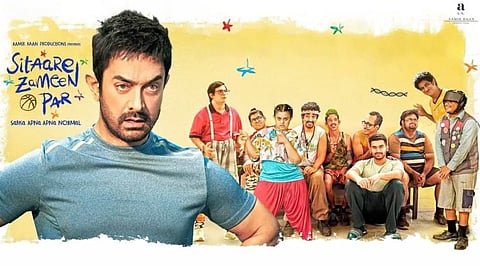

I was eleven when I watched a movie in a theatre for the very first time. I still remember the hush that fell as the lights dimmed, my first taste of caramel popcorn, and the quiet thrill of sitting with my mother and cousins, all waiting for the story to begin.
The year was 2007, and the movie was Taare Zameen Par.
The story follows Ishaan, a young boy grappling with dyslexia, misunderstood by his teachers, chastised by his parents, and dismissed as inattentive and indisciplined. His quiet struggle goes unnoticed, buried beneath labels and unmet expectations, until a compassionate teacher, played by Aamir Khan, finally sees him. He recognises Ishaan for who he truly is, someone with imagination, talent, and brilliance waiting to be nurtured. With patience and care, he helps Ishaan believe in himself and understand that he isn’t broken, just different.
I walked out of that theatre as a child myself, heart aching and full at the same time, trying to make sense of how one film could hold so much pain and so much light all at once.
For years, it remained one of my favourite films.
Seventeen years have passed since that day. I’ve moved countries and oceans, built a new life far from where it all began. My mother is no longer alive, and my cousins, now scattered across the United States, are faces I haven’t seen in years. Yet, that moment, sitting between familiar arms, the cool air of the theatre wrapping around us, and the quiet sobs we shared as the credits rolled, remains vivid.
Today, in another city and another chapter of my life, I watched Sitaare Zameen Par with my husband. As the lights dimmed and the screen flickered to life, a wave of memories surged back: of childhood, of loss, of love that lingers long after the people are gone. Some films don’t just tell stories; they become part of your own.
A spiritual successor to Taare Zameen Par, this film shifts from one child’s journey to a collective narrative of resilience and inclusion. It tells the story of children with intellectual and developmental disabilities, growing up in a world that often overlooks and underestimates them. At their special needs school, they’re encouraged to play basketball, not as a path to glory, but as a way to build confidence. The turning point comes when a new coach enters their lives and, reluctantly, steps in to train them for an interstate tournament.
This is where the most striking contrast between the two films unfolds, through Aamir Khan’s roles. In Taare Zameen Par, he portrayed Ram Shankar Nikumbh, a teacher whose inherent kindness and open-mindedness allowed him to see Ishaan’s potential when others saw only deficiency. He was the guide who helped a lost child understand that being different didn't mean being less.
But in Sitaare Zameen Par, Khan presents us with Gulshan, a character who begins at the opposite end of the emotional spectrum. Arrogant, impatient, and consumed by his own perceived superiority, Gulshan initially dismisses those who don't conform to his rigid standards. He represents the very mindset that once failed children like Ishaan.
Yet, it is through the time he spends with a group of remarkable children who quietly defy every conventional mold, Gulshan undergoes a profound metamorphosis. He is humbled, challenged, and ultimately transformed into someone capable of genuine compassion and understanding.
What emerges is a poignant irony: in Taare Zameen Par, it is the teacher who helped the child reclaim a sense of self the world had almost erased, while in Sitaare Zameen Par, it is the children who guide the teacher, gently but profoundly, back to the very compassion and clarity that defined Ram Shankar Nikumbh.
Watching Sitaare Zameen Par seventeen years after Taare Zameen Par felt like completing a circle that began in that darkened theatre of my childhood in Mumbai.
What stayed with me most was the film’s refusal to follow the typical sports movie arc. Instead of ending on a victory, the protagonists lose, yet they discover something far more valuable: genuine happiness and a sense of belonging. And that, the film suggests, is the real triumph.
It reminded me that life's true meaning isn't found in winning or achieving external markers of success. It’s about how we show up, for ourselves and for others, and how we find meaning, even when the outcome isn’t what we hoped for.
The stars may shine differently after seventeen years, but they still light the same path, one that shows me happiness isn’t something we chase. It’s something we choose, again and again, in the quiet, in the ordinary, and in circumstances beyond our control.
And when I reflect on that truth, I think of my mother, how her presence felt like home, and how her absence reminds me that happiness can be found even in the painful contours of grief.
Watching Aamir Khan seventeen years apart within the same narrative arc, I was reminded of all the ways I’ve changed, grieved, learned, and kept going. Some stories meet us once. Others walk alongside us.
(Angela Mary Thomas is a student. Views expressed are her own.)
